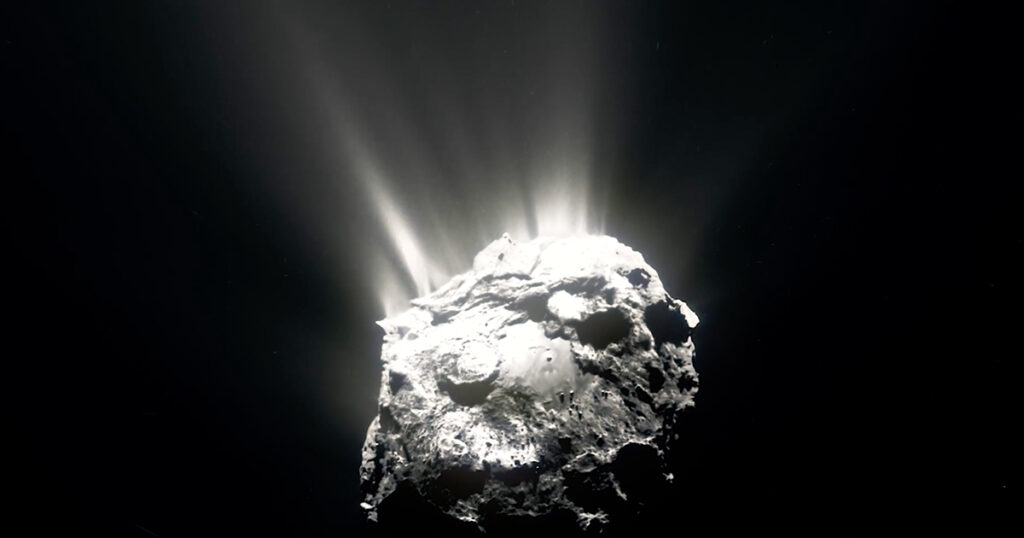But the chemical assembly process probably doesn’t end in the cloud. According to Booth, “we’ve got some really interesting results that might tell us that we’re enhancing [chemical] complexity during planet formation.”
As material moves around in the disk, it experiences dramatically varying conditions. The disk’s surface is exposed to heat and radiation, while its midplane is shielded and cooler. Just as wet-dry cycles on Earth might have helped drive organic complexity at the origin of life, the flow of dust and gas through different parts of disks might drive new kinds of organic complexity.
Researchers have wanted to computationally model the churn and tumble of disk material, but it’s so computationally costly to do so that “until we absolutely had to, we have sort of been avoiding those [studies],” Öberg said. That’s changing now. In 2024 a team of scientists including Booth published initial results of computer models showing that complex organics can form rapidly in protoplanetary disks. In particular, the molecules assemble in the same “dust traps” where planetesimals, the asteroid-size building blocks of planets, coalesce. The results provide a tantalizing link between the formation of organics and planets.
In our own solar system, comets are among the most primordial material — leftovers from the protoplanetary disk. “Comets are, I think, the best that we can do to go back in time toward what happens in the interstellar medium,” Hänni said. The inventory of small organic molecules that Rosetta detected so far in comet 67P mostly lines up with what scientists would expect of material inherited from molecular clouds in interstellar space. But some organic molecules from 67P are more complex than scientists expected, and it’s still an open question where that complexity came from.
Nora Hänni, a chemist at the University of Bern, has been identifying and analyzing the complex organic molecules detected in comet 67P by the European Space Agency’s Rosetta probe.
Asteroids are less pristine than comets, having often endured heating and the effects of liquid water. But these effects can produce dramatic new organic complexity. For decades, scientists have known that meteorites called chondrites, which originate from asteroids, contain a staggering diversity of organic molecules. The Murchison meteorite, which fell in Australia in 1969, contains more than 96 different amino acids. Life uses just 20 or so. Osiris-Rex and Hayabusa2 have confirmed that the asteroids Bennu and Ryugu are as complex as those meteorites. And at least some of this complexity seems to have arisen before the asteroids themselves: A preliminary analysis of the Bennu sample suggests it retained organic material, including polycyclic aromatic hydrocarbons, from the protoplanetary disk.
The Chemistry of Life?
Organic molecules on the early Earth took a new, remarkable step up in complexity. They somehow organized themselves into something alive. Some hypotheses for the origins of life on Earth involve a starter kit of organic material from space. The “PAH world” hypothesis, for instance, posits a stage of the primordial soup that was dominated by polycyclic aromatic hydrocarbons. Out of this slurry the first genetic molecules emerged.
In general, understanding how complex organics form in space and end up on planets might give us a better idea of whether life has arisen on other worlds, too. If the raw materials of life on Earth formed in the interstellar medium, the stuff of life should be everywhere in the universe.
For now, such ideas remain largely untestable. But because life itself represents a new level of organic complexity, astrobiologists are hunting for complex organics as a possible biosignature, or sign of life, on other worlds in our solar system.
The European Space Agency’s Juice mission is already on its way to study Jupiter and three of its icy moons, and NASA’s Europa Clipper mission launched toward one of those moons, Europa, in October. Both will use onboard instruments to search the atmospheres for organic molecules, as will the future Dragonfly mission to Saturn’s moon, Titan.
Yet it’s tricky to determine whether a given organic molecule is a biosignature or not. If scientists were to find sufficiently complex organic molecular assemblages, that would be enough to convince at least some researchers that we’ve found life on another world. But as comets and asteroids reveal, the nonliving world is complex in its own right. Compounds thought to be biosignatures have been found on lifeless rocks, like the dimethyl sulfide Hänni’s team recently identified on 67P.
Hänni wants to use the abiotic complexity of comets to help rule out false-positive biosignatures and inform future searches for life. “It doesn’t matter if you want to look at exoplanet atmospheres or search for life in your own solar system; I think comets are really a great benchmark,” she said.
Life aside, these studies about the organic chemistry of space also open a window onto processes we might never observe directly.
Glein and his colleagues have used James Webb Space Telescope observations of methane in the outer solar system as evidence that some icy Kuiper Belt objects could have warm, wet interiors. The organic molecules on Europa could reveal the chemistry of its subsurface ocean. And Schmitt-Kopplin has used the organic assemblages of meteorites to study impact shocks and geochemical processes at the birth of the solar system. Life is just one act of the enormous cosmic drama recorded in organic molecules.
“Organic chemistry — it’s just kind of normal chemistry in the universe,” Schmitt-Kopplin said. “You always have a coevolution of the mineral world with the organic world.”
Premium IPTV Experience with line4k
Experience the ultimate entertainment with our premium IPTV service. Watch your favorite channels, movies, and sports events in stunning 4K quality. Enjoy seamless streaming with zero buffering and access to over 10,000+ channels worldwide.

















